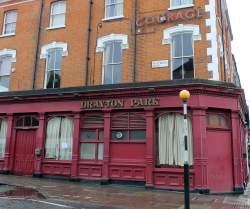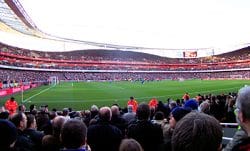 The Emirates stadium is of a good size being over 60,000 in capacity and is four-tiered all the way around, which looks impressive. The lower tier is large and shallow, set well back from the playing surface as a cinder track surrounds the playing area. A small second tier, which is called the Club tier, has seating but is only eight rows high. Inside there are number of lounges/restaurants, earning it the nickname the ‘prawn circle’. This Club tier slightly overhangs the bottom tier.
The Emirates stadium is of a good size being over 60,000 in capacity and is four-tiered all the way around, which looks impressive. The lower tier is large and shallow, set well back from the playing surface as a cinder track surrounds the playing area. A small second tier, which is called the Club tier, has seating but is only eight rows high. Inside there are number of lounges/restaurants, earning it the nickname the ‘prawn circle’. This Club tier slightly overhangs the bottom tier.
The third tier is even smaller, being entirely comprised of executive boxes, some 150 in total and fits entirely under the large fourth tier. This upper tier has been designed in a semi-circular fashion and is topped by a smart looking roof; the roof includes a lot of visible white tubular steelwork and perspex panels to allow more light to get to reach the pitch. The roofs though do not follow the semi-circular shape of the stands but in fact, run across the top of them and even dip down towards them giving them a strange look. Two excellent looking large video screens situated in the North West and South East corners, below the roof line, complete the stadium.
Outside of Arsenal’s Emirates Stadium, there are bronze statues of former manager Herbert Chapman and former players Tony Adams, Dennis Bergkamp and Thierry Henry. Dutch Dennis Bergkamp saw his statue added at a later date; Ken Friar – an iconic non-footballing story associated with Arsenal also has a statue in situ at the Emirates.
 The traditional pub for away supporters is the Drayton Park, which is located near to Arsenal tube station and Drayton Park railway station. This Courage pub overlooks the Emirates Stadium but, at present, is in a state of temporary closure. All is not lost though; for away fans can still grab a beverage at a couple of other places.
The traditional pub for away supporters is the Drayton Park, which is located near to Arsenal tube station and Drayton Park railway station. This Courage pub overlooks the Emirates Stadium but, at present, is in a state of temporary closure. All is not lost though; for away fans can still grab a beverage at a couple of other places.
Mark Long recommends the Twelve Pins (formerly the Finsbury Park Tavern) near Finsbury Park Tube Station. ‘Normally a good mix of home and away fans and about a ten minute walk from the ground’. Whilst Guy McIntyre adds; ‘The Blackstock opposite The Twelve Pins, also welcomes away fans, plus it has a big screen showing Sky Sports’.
Along Holloway Road and again around a ten minute walk from the Emirates Stadium is the Coronet; this is a Wetherspoons outlet. It normally has a good mix of home and visiting supporters on matchdays. Otherwise, alcohol is available inside the stadium; it will cost you a fair whack though with a pint costing around £6.
 Away fans at Arsenal’s ground, the Emirates Stadium, are housed in the lower tier of the South East corner. The normal allocation for away fans is just under 3,000 tickets, but this can be increased for cup games. Although fans have big padded seats and plenty of leg room, the lower tier of the stadium is quite shallow (unlike the upper tiers which have plenty of height between rows), meaning that the view might not be as good as you would expect from a modern stadium.
Away fans at Arsenal’s ground, the Emirates Stadium, are housed in the lower tier of the South East corner. The normal allocation for away fans is just under 3,000 tickets, but this can be increased for cup games. Although fans have big padded seats and plenty of leg room, the lower tier of the stadium is quite shallow (unlike the upper tiers which have plenty of height between rows), meaning that the view might not be as good as you would expect from a modern stadium.
After being searched by stewards outside the turnstiles, entrance to the stadium is gained via electronic turnstiles, where you need to enter your ticket into a bar code reader.
The concourse inside is not that spacious, but just about adequate but gets crowded quickly. There is quite a choice of food on offer, although some of it is rather pricey; that said, it’w what you expect for the city of London. The Club though does offer a Pie and a Drink at a reasonable price up to 45 minutes before kick off. If that sounds like something that appeals then happy days; just be aware that you’ll have a crowd to battle through. There are plenty of flat-screen televisions on the concourse to keep you entertained, plus there is a betting outlet.
I have been to the Emirates Stadium a couple of times now. The first was for an international friendly, where I had tickets for the upper tier of the stadium. I was very impressed all round with the stadium and had a great day out. The second visit was as an away supporter seated in the visiting section. On this visit, I was less impressed with the Emirates Stadium. The whole occasion just seemed as it was one big corporate event rather than a football match. Plus the view was that not that great and afterwards you almost questioned if the stadium did indeed hold 60,000, as the large gaps in the corners below the stadium roof, giving the illusion that it is smaller than what it is. The away fans are also located very close to the home fans, which led to a fair amount of rather unsavoury banter.
On the positive side the stadium is indeed one of quality. It looks and feels that it has not been ‘built on the cheap’ and is a ‘cut above’ most other new stadiums built in this country. The atmosphere is okay and the pitch even in January looked immaculate. On a lighter note look out for the rather odd looking mascot called ‘Gunnersaurus, which is not as you would expect coloured red and white, but instead a bright green, fluffy looking dinosaur. Card Payments are accepted for food and drink inside the stadium.
Leave the M1 at Junction 2 and onto the A1, following the signs for City (Central London). Keep going on the A1 for around six miles, until you see Holloway Road Tube Station on your right. Take the next left at the traffic lights into Hornsey Road and Arsenal’s Emirates stadium is about a 1/4 of a mile further down this road.
There is little parking at the stadium itself or in nearby streets. An extensive residents only parking scheme operates around the stadium on matchdays. It’s probably better to park further out of London around a tube station such as Cockfosters and get the tube to the ground. There is the Sobell Leisure Centre on Hornsey Road (N7 7NY). Just a 10 minute walk away from the Emirates Stadium, which costs £20 for up to five hours. You can pay by phone or via the RingGo App. There is also the option of renting a private driveway near to Arsenal’s ground via YourParkingSpace.co.uk.
Tony Attwood adds; ‘Cockfosters underground station is the obvious station for fans travelling from the north – it is only about 4 miles south of the M25. It has its own car park but this can be full by as early as 12.30pm. What’s more, it can be difficult to exit after the game, with most drivers seeking to come out and cross the main road to head north. Unless you have an encyclopedic knowledge of the streets around the general area of the Emirates, it really isn’t worth trying to find some street parking. Football fans on matchdays are easy pickings for the traffic wardens, who contrary to popular belief, do work on Saturday and Sunday afternoons.’
Post Code for SAT NAV: N5 1BU
 The nearest London Underground tube station to Arsenal’s Emirates Stadium is Holloway Road on the Piccadilly line. It is only a few minutes walk from the stadium, however, to exit this stadium you need to go up by lift or tackle a rather steep spiral staircase. Also please note that the station is also closed after matches. On exiting the station turn right, cross over the road to the other side and then turn left for the stadium. It may be a better idea to alight at the next stop on the Piccadilly line which is Arsenal tube station. Again it is only a few minutes walk from here to the stadium. On exiting the station turn right and follow Drayton Park Road around to the left. Then take one of the large bridges over the railway line to the stadium. Other tube stations in walking distance of the stadium are Finsbury Park on the Piccadilly Line and Highbury & Islington on the Victoria Line.
The nearest London Underground tube station to Arsenal’s Emirates Stadium is Holloway Road on the Piccadilly line. It is only a few minutes walk from the stadium, however, to exit this stadium you need to go up by lift or tackle a rather steep spiral staircase. Also please note that the station is also closed after matches. On exiting the station turn right, cross over the road to the other side and then turn left for the stadium. It may be a better idea to alight at the next stop on the Piccadilly line which is Arsenal tube station. Again it is only a few minutes walk from here to the stadium. On exiting the station turn right and follow Drayton Park Road around to the left. Then take one of the large bridges over the railway line to the stadium. Other tube stations in walking distance of the stadium are Finsbury Park on the Piccadilly Line and Highbury & Islington on the Victoria Line.
Otherwise you can take an overland train to Finsbury Park Railway Station from London Kings Cross. It is then about a 10 to 15 minute walk from Finsbury Park to the stadium. Drayton Park Station which is situated right by the stadium is closed at weekends.
Tim Sansom adds; ‘After the game we had to walk a fair distance to find an underground station that had not been shut due to overcrowding. We found that the Arsenal underground had been shut by the police and so had to undertake a fairly long walk to Finsbury Park which was also shut by station staff. We were recommended by the police to take the mainline train into Kings Cross, which we did with no problems and were back in central London within 10 minutes’.
Unless you are team are being stuffed and you are leaving the game a little early, then Arsenal tube station should be fine. If though you are staying to the final whistle, then you are better off walking to Finsbury Park, rather than wait in the long queues at Arsenal tube. To get to Finsbury Park, simple walk past Arsenal tube station on your left and then take a left into St Thomas’s Road. The station is at the end of the road. The Police also do a good job of controlling the flow of the numbers of fans onto the station.
For travelling across London by public transport I recommend planning your journey ahead with the use of the Travel For London Plan your journey website.
Given Arsenal’s ground, the Emirates, is located in the city of London it’s highly plausible that you’ll want do more than just take in the stadium. If that’s the case an overnight stay might appeal.
The four star Travelodge at Finsbury Park may well appeal with it’s cheap night price and close location; it’s under a mile away and can be walked within 15 minutes. It’s not your only option though; the Argyle Apart Hotel will cost you circa twice as much but is only half a mile from the Emirates.
Of course, if you’re happy to take our advice on finding the stadium, you’ve got a sickening number of hotel options to explore in the wider area.
The Club operates a category system for ticket prices (A, B & C), whereby the most popular games cost more to watch. This is common practice amongst clubs nowadays with category A matches typically costing more to watch at Arsenal’s Emirates stadium.
Adult tickets range from £26 up to £97.50 with juniors able to pick up tickets from as little as £10.
These ticket prices are provided courtesy of www.arsenal.com.
If you want to commemorate your day visiting Arsenal’s ground then an official programme will set you back £4.
That said, you have the option of picking up a fanzine at the Emirates Stadium too:
- Gunflash Fanzine £2.50
- The Gooner Fanzine £2
- Up The A**e Fanzine £1
Arsenal Tottenham Hotspur rivalry: When it comes to the biggest derby that takes to the Emirates Stadium pitch it is simply no contest. Arsenal and Tottenham hate each other. The two sides are separated by just a few miles in North London.
Arsenal Manchester United rivalry: Okay, so this rivalry has settled down a bit in recent years but only because neither club are close to the peak of their powers. Rewind to the years of Wenger vs Fergie and Vieira vs Keane though and, boy, was this match hot. It’s a long time back now but it still generates a buzz.
Arsenal Chelsea rivalry: Finally, on the subject of biggest rivals, we have Arsenal Chelsea. The bitterness between the two dates back nearly a century but has become more and more heated since Chelsea received Roman Abramovich’s millions. We guess that’s what happens when you’re the two most successful clubs in London.
Arsenal FC fixture list (takes you to the BBC Sports Website).
For details of disabled facilities and club contact at the ground please visit the relevant page on the Level Playing Field website.
The Club offers daily self-guided audio tours of the stadium. The cost of the tour (which also includes admittance to the Club Museum) starts at with adult prices from £27.
Tickets can be booked online via the official Arsenal FC website or by calling 020 7619 5000.
The Club also offers tours on matchdays at an additional cost.
Record Attendance
At The Emirates Stadium: 60,383 v Wolverhampton Wanderers Premier League, 2nd November 2019.
At the Arsenal Stadium (Highbury): 73,295 v Sunderland Division One, March 9th, 1935.
Average Attendance
- This season: 58,729
- 2020-2021: N/A
- 2019-2020: 47,589
- 2018-2019: 59,899
For the younger generation, all they’ll know of Arsenal’s stadium is the Emirates. It hasn’t always been that way though. The early years saw them playing ala Sunday League style on Plumstead Common before a move to Manor Ground and, again, to Invicta Ground. Invicta Ground had a capacity of 12,000 but the club opted for a move back to Manor Ground, which was simply a pitch. Stands were erected though with Arsenal playing their for over a decade.
In 1913, Arsenal relocated again. This time they moved into Highbury; they’d remain there through to 2006. Over the years, Arsenal’s Highbury Stadium went through the wars – literally. Open air terraces saw roofs added, then one was bombed. Capacities were squeezed by regulation with the early nineties eventually seeing it become fully seated. From there, their move out was a matter of time; the club was having success and regulation around listed buildings made expansion impossible hence we now have the Emirates stadium.
Special Thanks to:
Owen Pavey for providing the ground layout diagram and external photo of the stadiu
If anything is incorrect or you have something to add, please e-mail me at: contact@footballgroundguide.com and I’ll update the guide.
Content retrieved from: https://footballgroundguide.com/leagues/england/premier-league/emirates-stadium-arsenal.html.
This article first appeared on JACKARMY.net.

